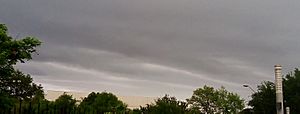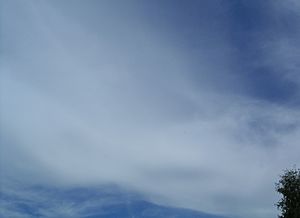Stratus cloud facts for kids
Quick facts for kids Stratus cloud |
|
|---|---|

Stratus nebulosus opacus cloud
|
|
| Abbreviation | St |
| Symbol | |
| Genus | Stratus (layered) |
| Species |
|
| Variety |
|
| Altitude | 0-2,000 m (0-7,000 ft) |
| Classification | Family C (Low-level) |
| Appearance | Gray, featureless low-altitude cloud capable of ground contact. |
| Precipitation | Common Drizzle, freezing drizzle, Snow or snow grains |
Stratus clouds are low-level clouds that look like flat, gray sheets spread across the sky. Unlike puffy cumulus clouds that grow upwards, stratus clouds form in layers. The word stratus comes from a Latin word meaning "layer," which perfectly describes them!
These clouds often look like a uniform, hazy blanket. They can be dark gray or almost white. Stratus clouds are very close to the ground, sometimes even touching it. You might think of them as "high fog" because they often form when morning fog lifts, or when cool air moves low to the ground. They can bring light drizzle or a small amount of snow.
Contents
How Stratus Clouds Form
Stratus clouds form when a layer of air near the ground is gently lifted. As this air rises, the pressure around it drops. This makes the air cool down. When the air cools, the amount of moisture it can hold decreases, and its relative humidity goes up. Eventually, the air becomes saturated, and tiny water droplets or ice crystals form, creating the cloud. This usually happens when the air is very stable, meaning it's not moving up and down a lot.
What Stratus Clouds Look Like
Stratus clouds usually appear as a flat, featureless sheet that stretches across the sky. They can be gray or white. Depending on how cold it is, these clouds can be made of tiny water droplets, supercooled water droplets (water that's colder than freezing but still liquid), or even ice crystals.
Types of Stratus Clouds
Stratus clouds have different forms based on how they look or how they are made.
Main Species
- Stratus nebulosus clouds are smooth, featureless layers of stratus clouds. They don't have any distinct shapes or patterns. When you see them, it often means the weather will stay calm and stable. They can produce light rain or snow.
- Stratus fractus clouds are the opposite! They look broken, ragged, and have irregular shapes. You often see them forming underneath larger rain clouds like nimbostratus or cumulonimbus clouds. They can also form near mountain slopes. Their color can range from dark gray to almost white.
How Much Light They Block
Stratus nebulosus clouds can be divided into two types based on how much light they let through:
- Stratus opacus clouds are thick and opaque. They are dense enough to completely block the sun from view.
- Stratus translucidus clouds are thinner. They are translucent, meaning you can still see the position of the Sun or Moon through them.
Wavy Stratus Clouds
There's one type of stratus cloud that has a wavy pattern:
- Stratus undulatus clouds are rare, but they show gentle waves or ripples. This happens when there are slight changes in wind speed or direction within the cloud layer.
Stratus Clouds from Other Clouds
Sometimes, stratus clouds form from other types of clouds:
- Stratus cumulogenitus clouds form when the base of a cumulus cloud spreads out, creating a flat, stratus-like layer.
- They can also form from nimbostratus clouds (stratus nimbostratogenitus) or cumulonimbus clouds (stratus cumulonimbogenitus).
- Stratus clouds can even be formed by human activities (Stratus homogenitus), from the spray of waterfalls (Stratus cataractagenitus), or from moisture evaporating from a forest (Stratus silvagenitus).
What Stratus Clouds Mean for the Weather
If you see stratus clouds, it often means you'll have cloudy weather with light drizzle for several hours. They can stick around for days, especially during calm, high-pressure weather systems. Sometimes, stratus clouds form instead of the usual rain clouds during a weak warm front.
Stratus Clouds and Climate
Stratus clouds, especially in the Arctic, cover a lot of the sky. They play a big role in how much energy the Earth absorbs and releases. This means they have a large effect on the climate, especially in polar regions.
How Stratus Clouds Relate to Other Clouds
Cirrostratus Clouds
Cirrostratus cloud Cirrostratus clouds are very high-up clouds made of ice crystals. They can look like a milky haze or a thin, layered sheet in the sky. You can always see the Sun or Moon clearly through them, which helps tell them apart from other clouds. These clouds often create beautiful halos around the Sun or Moon. They form when warm, moist air slowly rises very high into the atmosphere. When a warm front is coming, cirrostratus clouds get thicker and lower, often turning into altostratus clouds. Rain usually starts about 12 to 24 hours later.
Stratocumulus Clouds
Stratocumulus clouds are another common type of low-level cloud. Like stratus clouds, they form low in the sky. But like cumulus clouds, they form because of rising warm air. However, their upward growth is stopped by a strong temperature inversion (where air temperature increases with height), which makes them flatten out into layers, similar to stratus clouds.
These clouds are very common, covering a large part of Earth's oceans and continents. They reflect a lot of sunlight back into space, which helps to cool the Earth. Stratocumulus clouds can produce light drizzle.
See also
 In Spanish: Stratus para niños
In Spanish: Stratus para niños




